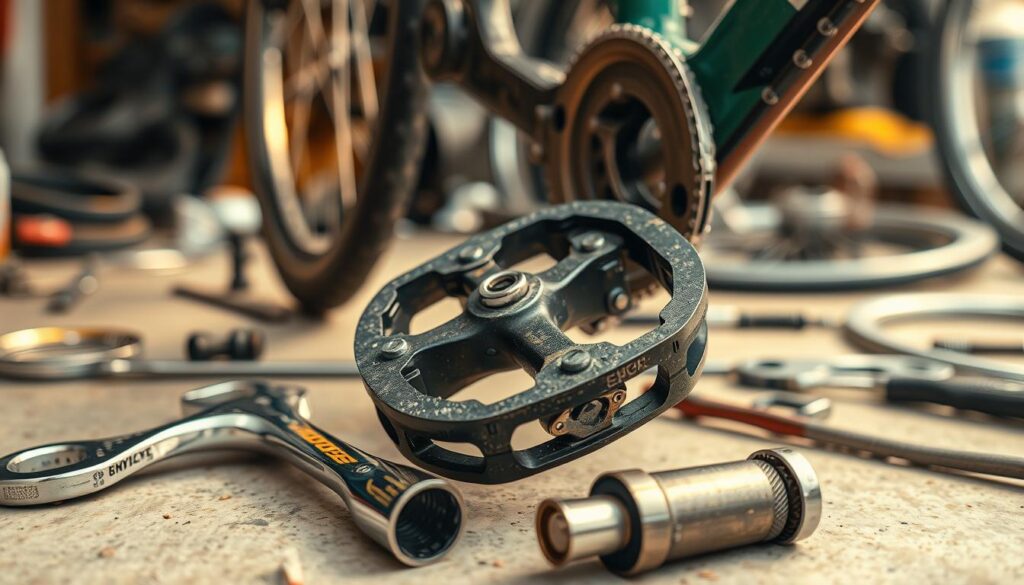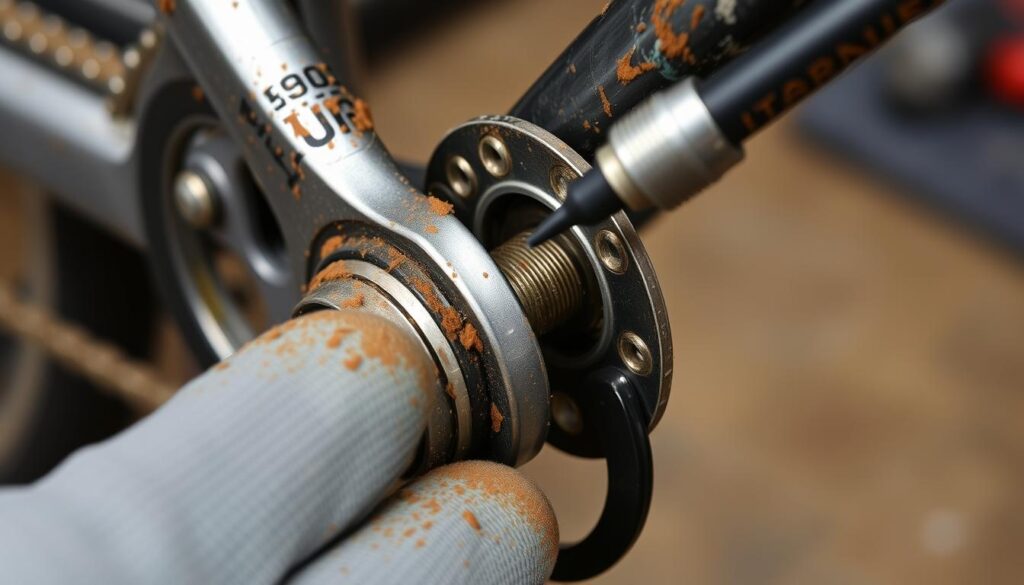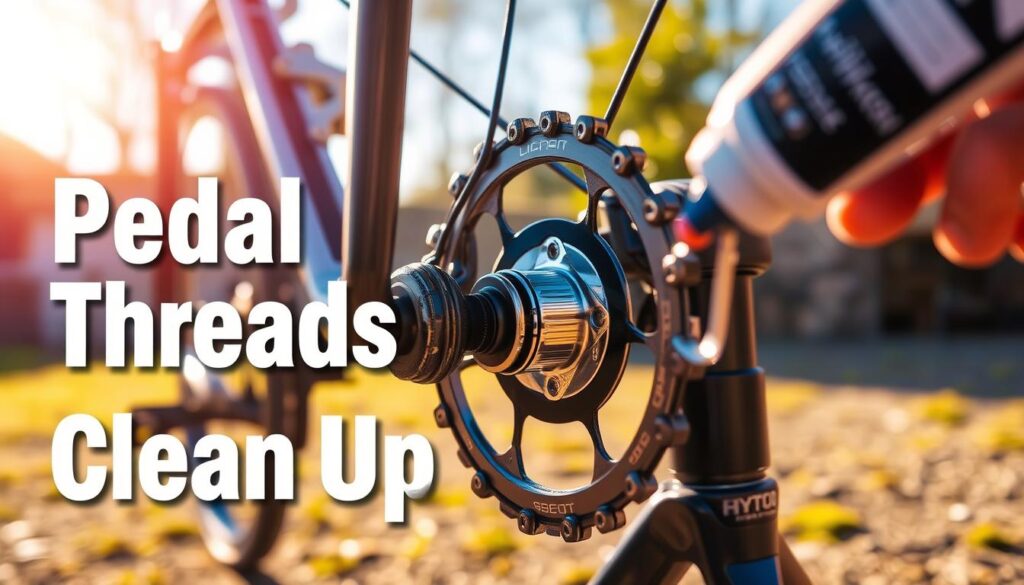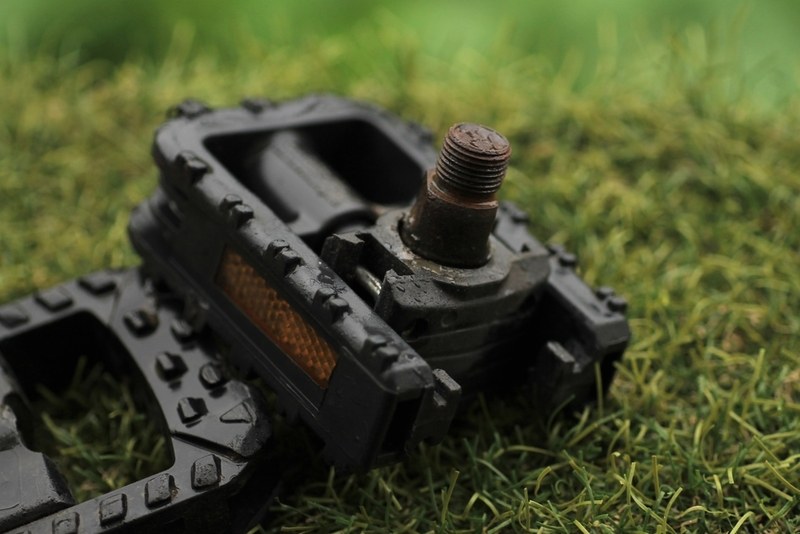Ever found yourself stuck on the side of the road with a loose pedal? It’s a common problem for cyclists. Knowing how to fix a bicycle pedal can make all the difference. It’s not just about convenience; it’s about enjoying your ride.
In this guide, we’ll cover the basics of fixing bicycle pedals. You’ll learn how to tackle common issues. This way, you can keep your bike in top shape and avoid future problems. Let’s get your bike running smoothly again!
Understanding Bicycle Pedals
Before we dive into fixing bicycle pedals, let’s get some basics down. Knowing what a pedal bike is and the different types of pedals is key. It helps with keeping your bike in top shape.
What is a Pedal Bike?
A pedal bike is a bike you pedal to move. Unlike electric bikes, it lets you control your ride. It makes cycling a fun and active way to get around.

Types of Bicycle Pedals
Knowing about the different pedals can make your ride better. Here are the main kinds:
- Platform Pedals: These have a flat surface for your feet. They’re great for casual rides and getting to work.
- Clipless Pedals: These pedals lock your shoes in place. They’re perfect for racing and serious cycling.
- Toe Clips: Similar to clipless pedals but with a cage. They offer a mix of both designs.
Choosing the right pedal is important. It depends on how you like to ride. Whether you’re just out for a casual ride or racing, the right pedal makes a big difference.
How to fix a bicycle pedal?
Fixing a bicycle pedal can save you time and make riding safer. Knowing common pedal problems helps you fix them early. Here, we’ll look at common pedal issues and the tools you need to repair them.
Common Issues with Bicycle Pedals
As a cyclist, you might face several pedal problems. Spotting these issues early helps you fix them quickly:

- Looseness: Pedals can loosen over time, affecting your ride, especially flat pedals easy to loosen because they typically rely on a simple, threaded attachment.
- Poor threading: Stripped threads make it hard to attach pedals.
- Bearing failure: Worn bearings can make pedaling feel rough.
Tools You’ll Need for Repair
Having the right tools and equipment makes fixing pedals easier. Here are the essential tools you’ll need:
- Pedal wrench – A special wrench for tightening or loosening pedals.
- Socket set – Useful for many bike parts, including pedals.
- Pedal grease – Needed for lubricating threads and bearings for smooth operation.
- Small File – is used to smooth and refine pedal components, removing burrs and imperfections for a precise fit.

Step-by-Step Guide to Fixing a Loose Bicycle Pedal
Dealing with a loose bicycle pedal can be frustrating. Luckily, fixing loose bicycle pedal issues is often straightforward. This guide provides insights on identifying the problem, tightening the pedals, and checking for any damage to the threads.
Identifying the Problem
Start by checking if the pedal is really loose. If it wobbles or moves when you press on it, it’s loose. This can happen from regular use or if it wasn’t installed correctly. If you hear a clicking sound while pedaling, it’s another sign you might need to fix it.
Steps to Tighten Loose Pedals
- Gather the necessary tools, including a pedal wrench and possibly some grease for maintenance.
- Place the bike on a stable surface, preferably a repair stand.
- Use the pedal wrench to tighten the left pedal by turning counterclockwise and the right pedal by turning clockwise.
- Ensure you apply enough torque without over-tightening, which may damage the threads.
- Test the pedal by pedaling gently to confirm it’s secure.
Checking for Damaged Threads
After tightening, check for damaged threads. If the pedal still wobbles, you might have stripped threads. Look for any visible damage on the pedal and crank. If you see stripped threads, you might need to repair or replace parts to keep your bike running smoothly.

DIY Bicycle Pedal Fix and Maintenance Tips
Keeping your bicycle pedals in good shape is key for a smooth ride. Knowing how to fix pedal crank and bike pedal bearings can save you money and time. Here are some essential tips and methods for a successful DIY pedal fix and maintenance.
How to Fix Pedal Crank on a Bike

Loose crank arms can make cycling tough. To fix this, first:
- Remove the pedal using a wrench.
- Check the crank arm. If it’s damaged, you might need a new one.
- Then, tighten the crank bolts well. Make sure they’re snug but not too tight.
This should make your crank stable again, for a better ride.
How to Fix Bike Pedal Bearings
Bike pedal bearings can wear out over time, making pedaling hard. To fix this, follow these steps:
- First, take off the pedal from the crank arm.
- Then, get to the bearings by taking apart the pedal casing.
- Clean and oil the bearings well to make them move smoothly.
- Put the pedal back together, making sure everything fits right.
Doing these steps will keep your pedaling smooth and prevent damage.
Bicycle Pedal Maintenance Tips

Regular care is vital for your bike pedals to last long. Here are some tips for keeping your pedals in top shape:
- Check for wear or damage often.
- Lubricate the pedal bearings every month.
- Pedal Threads Clean Up: Regularly clean the pedal threads to prevent dirt buildup and ensure a secure fit
- Keep the pedal threads clean to avoid rust.
- Store your bike right to avoid moisture.
Following these tips will make your pedals last longer and your rides smoother.
Conclusion
Learning how to fix a bicycle pedal is key to keeping your bike in great shape. This guide has shown you how to solve common problems and maintain your pedals for a smoother ride. Regular care can make your cycling better, reducing the risk of unexpected issues.
By following the steps in this article, you can fix pedal problems on your own. Knowing a bit and having the right tools lets you handle repairs well. Whether it’s tightening loose pedals or fixing bearings, you’re set to keep your bike in top condition.
With time, fixing bicycle pedals will become easy and rewarding. A well-maintained bike means safer and more enjoyable rides for you.
FAQs
How can I tell if my bicycle pedal is loose?
Check if your pedal is loose by gently wiggling it. If it moves a lot or feels shaky, tighten it.
What tools do I need to fix a bicycle pedal?
You’ll need a pedal wrench, a socket set, and grease. You might also need a thread repair kit if threads are damaged.
How do I fix a bike pedal that fell off?
First, check the pedal threads for damage. If they’re okay, just screw the pedal back on the crank arm. Tighten it well to keep it from falling off again.
What are common issues with bicycle pedals?
Issues include looseness, stripped threads, and bearing failure. Fixing these problems early keeps your bike safe and running well.
How do I repair damaged bike pedal threads?
Use a thread repair kit like a Helicoil for damaged threads. It lets you put a new threaded coil in the crank arm, fixing the pedal’s hold.
How do I fix the pedal crank on a bike?
Tighten the crank arm bolts to fix a loose pedal crank. If bolts are stripped, you might need a new crank or a thread repair kit.
How do I remove the pedals on a road bike?
Use a pedal wrench to remove pedals. Turn counterclockwise for the left pedal and clockwise for the right. Clean and grease the threads before putting them back on.
What maintenance tips can help with bicycle pedals?
Check pedals for wear, keep threads clean, and lubricate bearings. Tighten bolts as needed. These steps help your pedals last longer and ride better.
How do I fix bike pedal bearings?
To fix bearings, disassemble the pedal, clean it, replace worn bearings, and re-grease. Then, reassemble for smooth pedaling.

